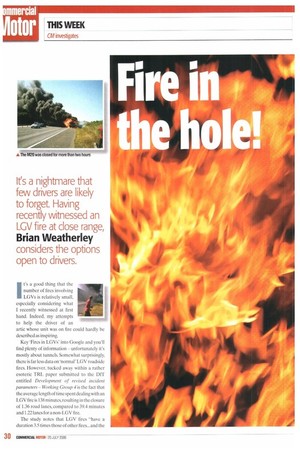It's a nightmare that few drivers are likely to forget.
Page 30

Page 31

If you've noticed an error in this article please click here to report it so we can fix it.
Having recently witnessed an LGV fire at close range, Brian Weatherley considers the options open to drivers.
1 t's a good thing that the number of fires involving LGVs is relatively small, especially considering what I recently witnessed at first hand. Indeed, my attempts to help the driver of an artic whose unit was on fire could hardly be described as inspiring.
Key 'Fires in LGVs' into Google and you'll find plenty of information — unfortunately it's mostly about tunnels. Somewhat surprisingly, there is far less data on 'normal' LGV roadside fires. However, tucked away within a rather esoteric TRL paper submitted to the DUI' entitled Development of revised incident parameters — Working Group 4 is the fact that the average length of time spent dealing with an LGV fire is 138 minutes, resulting in the closure of 1.36 road lanes, compared to 39.4 minutes and 1.22 lanes bra non-LGV fire.
The study notes that LGV fires "have a duration 3.5 times those of other fires_ and the duration of lanes closed is 12% more than for other fires... This suggests the differentiation between LG V and non-LCIV is worthwhile..."
And following my recent brush with a blaze, it is a view I would agree with. While drivin.g south on the M20 I spotted fire and smoke coming from the gap between the tractive unit and trailer of a Dutch-registered artic combination, So, too, had the driver, who was in the act of pulling over.
Having stopped on the hard shoulder, and grabbing what turned out to be a woefully inadequate fire extinguisher. I tried to help put out the flames coming from the trailer's fridge unit. It was spewing out blazing material onto the tractor chassis below, which had also ignited.
It was soon obvious we couldn't contain the fire, and shortly after the driver retrieved his personal possessions from the doomed cab we beat a hasty retreat.The time between the artic stopping and abandoning our attempt to contain the fire was little more than three minutes.
Dangerous debris The subsequent detonations from the exploding tyres and fuel tank on the tractor were as spectacular as they were frightening, with debris being fired across the lanes of both carriageways as other motorists blithely drove past. Apart from myself, the only other person who stopped was a Dutch bulk tanker driver who wisely warned us to keep our distance.
Kent Fire and Rescue Service (KFRS) needed six appliances, a water unit and 36 firefighters to put out the resulting blaze, which shut the motorway for more than two hours. The fire was so fierce that both the hard shoulder and the inside lane in the immediate vicinity needed resurfacing.
In retrospect it is tempting to ask: "What more could have been done?" KFRS say-s:"The safety message we'd have for drivers and passengers is to get to a safe location and let the professionals fight the fire," No one would argue with that, but there is the nagging feeling that had we been able to quickly separate the unit from the trailer, the ultimate impact of the blaze might have been reduced.
No plan of action t.; nfortunately, with no clear plan of action at the critical moment it was hardly surprising that neither I nor the driver was able to act effectively. If we had been able to uncouple the fifth wheel and simply pull out from under the trailer (which by then was well ablaze around the front bulkhead and fridge), even damaging the back of the truck would have been preferable to having it completely destroyed. And separated, we might just have been able to contain or even extinguish the fire on the rear of the tractor. But hindsight is always 20:20.
Certainly a fire extinguisher bigger than the modest 1 kg unit I was carrying would undoubtedly have been more effective, while from what I could see the driver of the lorry involved didn't appear to have one.
In conversation with a major UK tanker operator I was told: The most recent A DR regs require 12kg of fire extinguishing capacity to be carried, of which 2kg should be in the cab. We put one 6kg unit on either side of the trailer and have an extra 3kg in the cab if you had a single 12kg extinguisher you'd run into manual handling problems..."
ADR or not, that sounds like a sensible requirement for any truck.
Likewise, another fleet told CM: "If a driver has time to split the unit we'd say pull the pin and get the unit out fast -regardless of dropping the trailer on its nose."
However, the speed with which a fire can spread will ultimately take such decisionmaking out of the driver's hands. In the long run, "leaving it to the professionals" could be your only possible option. • • Have you ever experienced a fire on your vehicle? If so e-mail Brian Weatherley at hrian.weatherley@rbi.coatk
























































































































































































